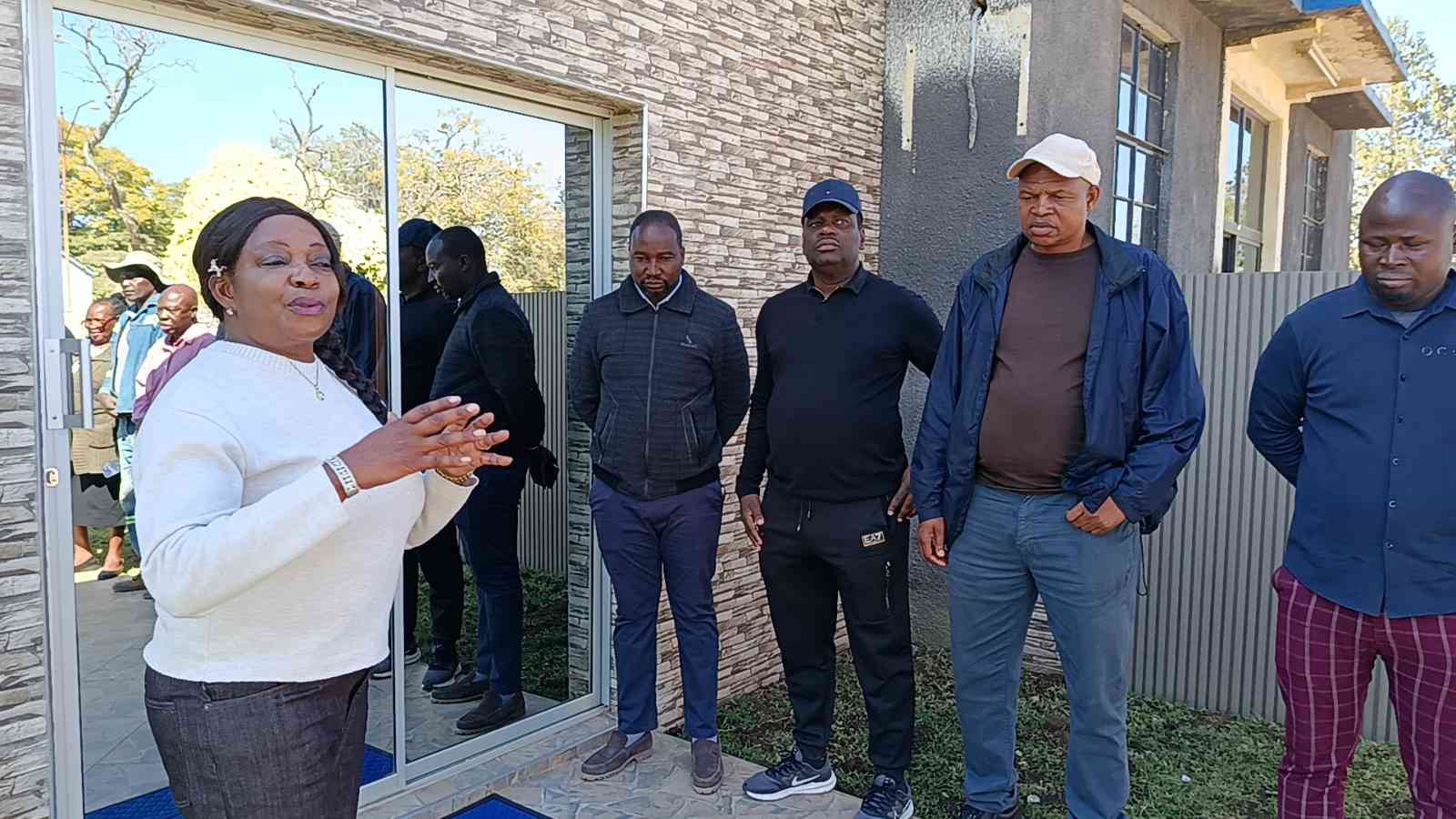
It is afternoon and dark rain clouds hang threateningly over the otherwise serene Maanhu village in Marange, about 100km from Mutare.
BY FARAI SHAWN MATIASHE
Selina Mamire (20) is kneeling outdoors blowing on smoking wood to start a fire.
Mamire is preparing soup to serve her husband Fungai Muuya (32), and their 16-month-old daughter Chelsea for supper. This will be their second and last meal of the day.
Chelsea is precious to Mamire and Muuya as they lost their first-born child at the age of only one month in 2019.
Muuya said he was struggling to put food on the table for his family.
He earns some money from herding other people’s cattle, but says: “I do not earn much from the jobs that I do get.
“I am failing to make ends meet.”
- Chamisa under fire over US$120K donation
- Mavhunga puts DeMbare into Chibuku quarterfinals
- Pension funds bet on Cabora Bassa oilfields
- Councils defy govt fire tender directive
Keep Reading
Muuya takes home a paltry wage of $950 a month, which is insufficient to meet the family’s needs.
The total consumption poverty line for one person stood at $4 426 (US$49) in November 2020, according to the Zimbabwe National Statistics Agency.
Due to drought in the 2019/2020 season, Muuya’s family did not harvest enough grain to last them through to April 2021, when the next crop harvest is due, leaving the family without enough food and often hungry. It is Chelsea who has felt the pain of food insecurity the most.
The World Health Organisation (WHO) and United Nations Children’s Fund (Unicef) recommend that young children should be exclusively breastfed until the age of six months and then have continued breastfeeding along with nutritious solid food up to two years of age or beyond.
But since she reached the age of six months, it has been a struggle for Mamire to provide nutritious food for Chelsea due to the failed harvest and a low income.
“The only food that I can give my daughter daily is sadza, served with vegetables, or plain porridge with no sugar which she often declines,” Mamire said.
“She started losing weight and had continuous diarrhoea followed by vomiting.”
Mamire said when her first born became ill after birth, she did not seek medical help.
And initially when Chelsea became unwell, she did not seek medical assistance either because, as a member of the Zvakazarurwa Zvomweya – an Apostolic church sect – visiting a health centre to seek medical care is considered taboo.
She said she weaned Chelsea at 14 months because her Shona tradition dictates that a child is not supposed to be breastfed for long if the mother has just lost another child.
But even if there were no issues with her culture and religion, Mamire would have had to walk for nearly 15km with Chelsea strapped on her back, to get to her village’s nearest health centre, Chikwariro clinic.
The young mother’s headaches are over though.
Irish aid agency, GOAL Zimbabwe, through the Nutrition Emergency Response for Early Detection and Treatment (NERET) programme funded by the European Union Humanitarian Aid, has come to the rescue of Chelsea, and thousands of other malnourished young children like her in Zimbabwe.
GOAL Zimbabwe is supporting the Ministry of Health and Child Care on the NERET programme, which identifies and provides life-saving treatment for severe acute malnutrition (SAM) and moderate acute malnutrition (MAM) in children under the age of five in six districts in Zimbabwe.
It involves the training of village health workers (VHWs), outreach campaigns for nutrition and health services provision, social mobilisation for community leaders and caregivers training on the family mid-upper arm circumference (MUAC) approach.
The NERET programme, which is being rolled out in Masvingo Rural, Bikita, Gutu, Buhera, Mutare Rural and Chipinge districts, will support more than 7 700 malnourished children.
It was VHW Julia Chimbundinga (47) who referred Mamire to an outreach point 4km from her home for assessment and treatment when she realised that Chelsea was malnourished.
“I discouraged them from seeking help from traditional doctors after concluding that her daughter needed urgent medical help,” Chimbundinga said.
Mamire was assisted by health workers at the outreach point and referred to Chikwariro clinic in December.
The clinic referred Chelsea to the Victoria Chitepo Provincial Hospital in Mutare, the fourth largest city in Zimbabwe. The NERET programme helped with transport.
Said Mamire: “My daughter was treated for two weeks in the hospital for malnutrition.
“She was discharged after Christmas and I was told to bring her to Chikwariro clinic every two weeks for checkups.”
As part of her recovery from malnutrition, Mamire was given plumpy nut – a peanut-based therapeutic food for young children.
Super cereal plus porridge was provided for the rest of the family.
Mamire was also trained to check Chelsea’s nutritional status at home using the MUAC tape.
This tape measures the width of a child’s arm and is colour-coded in red, yellow and green to indicate the nutritional status of a child.
“I am glad that I have the MUAC tape to check Chelsea’s health. It is so easy to use,” Mamire said.
Chelsea and her family are among millions in Zimbabwe who are struggling with food insecurity every single day.
At the end of 2020, the United Nations (UN) World Food Programme estimated that the number of food-insecure Zimbabweans was 8,6 million people – a staggering 60% of the population.
A combination of factors are to blame.
Zimbabwe is experiencing its worst economic crisis in decades with a three-figure inflation rate leading to an increase in the cost of living.
The prices of basic commodities including maize, the staple cereal, have gone beyond the reach of many.
Lack of rain leading to drought has hit subsistence farmers like Mamire’s family hard. They account for three-quarters of Zimbabwe’s population.
The southern African nation, which was once the breadbasket of the continent, will import an estimated 1.1 million tonnes of grain in the 2020/2021 marketing year to meet demand, according to the UN’s Food and Agriculture Organisation.
Covid-19 has also had a huge impact, ravaging the economy and leaving many Zimbabweans locked up in their homes.
This has seen an unprecedented rise in child malnutrition cases in the country.
According to the Zimbabwe Vulnerability Assessment report, the percentage of children receiving the minimum acceptable diet necessary for growth and development declined from 6,9% in 2019 to 2,1% in 2020.
Zimbabwe is still recovering from the impact of Cyclone Idai which ravaged crops and left communities, supported by GOAL Zimbabwe, food-insecure in 2019, including in Chipinge.
And there is a fear that Cyclone Eloise, which hit Chipinge this year, in mid-January, will fuel malnutrition cases.
GOAL Zimbabwe is currently carrying out an assessment with the government.
Another success story from the ECHO-funded NERET programme is that of 18-month-old Vimbai Gono from Manyaya village.
Vimbai, who lives with her grandmother, has recovered from malnutrition after receiving treatment under the programme.
“She had lost weight. The VHW assisted me and she received treatment,” said Maggie Gumbo, Vimbai’s grandmother.
They were given plumpy nut from the health clinic for the baby and porridge for other family members through the NERET programme as well as MUAC tape to measure Vimbai’s weekly nutritional status.
Ministry of Health and Child Care nutrition assistant for Mutare district, Pardon Binde, said there was empirical evidence that these interventions were working.
“There was a knowledge gap in the implementation by our staff, especially those manning the rural health facilities,” Binde said.
“Capacity building training was arranged with the support from GOAL Zimbabwe.
“It started with staff at district level where we had sensitisation meetings.
“Capacity building training was then rolled out to rural areas targeting VHWs and nurses.”
GOAL Zimbabwe has to date trained a total of 2 897 VHWs and 617 nurses on how to tackle malnutrition in six districts in Manicaland and Masvingo provinces.
GOAL Zimbabwe country director Gabriella Prandini told The Standard that the NERET programme tackled malnutrition starting at grassroots level.
“The ability to work at grassroots level with VHWs and through the outreach approach ensures that villagers, even those in remote areas, are sensitised and information related to malnutrition and its early detection is provided,” Prandini said.
“Family-led MUAC at a time of Covid-19 also ensures that caregivers are empowered to detect malnutrition in their households, and therefore seek assistance at the nearest health facility or outreach point.”
EU humanitarian aid expert for Zimbabwe, Sylvie Montembault, said the humanitarian situation in Zimbabwe has been desperate for some years, with consecutive droughts and flooding leading to crop failures and severe food insecurity for the population.
“The EU supports projects such as this one by GOAL Zimbabwe because we are committed to help the most affected, especially children under five years, to get the life-saving food and treatment they need to recover,” Montembault said.
As at November 2020, 62% (4 768) of the estimated target of 7 773 children were identified and treated for acute malnutrition across the six districts, with 78,5% of these children successfully treated which is above the 75% threshold for minimum sphere standards target, according to GOAL Zimbabwe.
Binde said through the NERET programme they had been able to detect malnutrition early.
There had not been any death from malnutrition reported in Mutare district for the past five months, he said.
“Malnutrition can be cured as long as it is detected early,” Binde said.
Meanwhile Mamire, Chelsea’s mother, hopes to pass the knowledge gained which helped her daughter recover from life-threatening malnutrition to other women in Maanhu village.
“I do not want other mothers to go through the pain that I went through when my daughter was ill. I am going to educate them,” she said.










